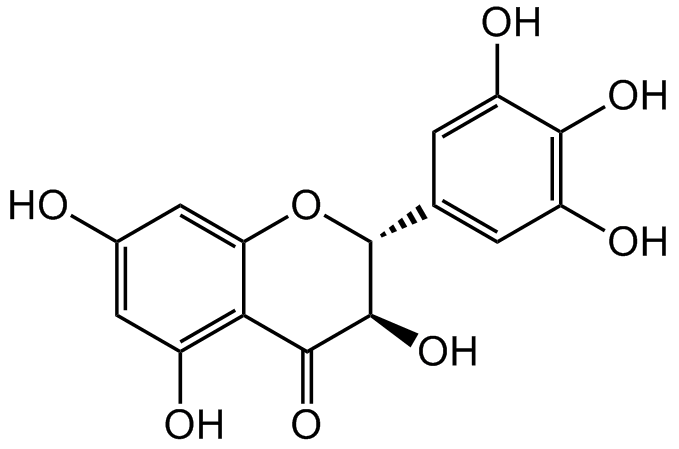
Chemical Structure
Dihydromyricetin
CDX-D0381
CAS Number27200-12-0
Product group Chemicals
Estimated Purity>98%
Molecular Weight320.25
Overview
- SupplierChemodex
- Product NameDihydromyricetin
- Delivery Days Customer10
- CAS Number27200-12-0
- CertificationResearch Use Only
- Estimated Purity>98%
- Molecular FormulaC15H12O8
- Molecular Weight320.25
- Scientific DescriptionChemical. CAS: 27200-12-0. Formula: C15H12O8. MW: 320.25. Dihydromyricetin is a flavanonol originally isolated from A. grossedentata. Dihydromyricetin has been demonstrated to show antioxidative, anti-inflammatory, anticancer, antimicrobial, cell death-mediating, neuroprotective and lipid and glucose metabolism-regulatory activities. It also has been found to have anti-alcohol intoxication effects, associated with its action as a positive modulator of GABA-A receptors at the benzodiazepine site. Dihydromyricetin may scavenge ROS to protect against oxidative stress or potentiate ROS generation to counteract cancer cells selectively without any effects on normal cells. Dihydromyricetin may be associated with several different molecules involved in cellular apoptosis, oxidative stress and inflammation, such as AMP-activated protein kinase (AMPK), mitogen-activated protein kinase (MAPK), protein kinase B (Akt), nuclear factor-kappaB (NF-kappa), nuclear factor E2-related factor 2 (Nrf2), ATP-binding cassette transporter A1 (ABCA1) or peroxisome proliferator-activated receptor-gamma (PPARgamma). It has been reported to effectively modulate growth factor receptor (VEGFR2 and PDGFRbeta) mediated signaling, TRAIL/TRAIL-R pathway, JAK/STAT and mTOR-driven signaling in different cancers. It has been shown to stimulate irisin secretion and to inhibit NLRP3 inflammasome-dependent pyroptosis. It also has anti-neuroinflammatory activities in Alzheimers and Parkinsons diseases and improves conginitve deficits. It acts as a potential preventive or therapeutic agent in treating multiple diseases, such as diabetes mellitus, atherosclerosis, nonalcoholic fatty liver disease and osteoporosis. - Dihydromyricetin is a flavanonol originally isolated from A. grossedentata. Dihydromyricetin has been demonstrated to show antioxidative, anti-inflammatory, anticancer, antimicrobial, cell death-mediating, neuroprotective and lipid and glucose metabolism-regulatory activities. It also has been found to have anti-alcohol intoxication effects, associated with its action as a positive modulator of GABA-A receptors at the benzodiazepine site. Dihydromyricetin may scavenge ROS to protect against oxidative stress or potentiate ROS generation to counteract cancer cells selectively without any effects on normal cells. Dihydromyricetin may be associated with several different molecules involved in cellular apoptosis, oxidative stress and inflammation, such as AMP-activated protein kinase (AMPK), mitogen-activated protein kinase (MAPK), protein kinase B (Akt), nuclear factor-kappaB (NF-kappa), nuclear factor E2-related factor 2 (Nrf2), ATP-binding cassette transporter A1 (ABCA1) or peroxisome proliferator-activated receptor-gamma (PPARgamma). It has been reported to effectively modulate growth factor receptor (VEGFR2 and PDGFRbeta) mediated signaling, TRAIL/TRAIL-R pathway, JAK/STAT and mTOR-driven signaling in different cancers. It has been shown to stimulate irisin secretion and to inhibit NLRP3 inflammasome-dependent pyroptosis. It also has anti-neuroinflammatory activities in Alzheimers and Parkinsons diseases and improves conginitve deficits. It acts as a potential preventive or therapeutic agent in treating multiple diseases, such as diabetes mellitus, atherosclerosis, nonalcoholic fatty liver disease and osteoporosis.
- SMILESO[C@H]1C(C2=C(O)C=C(O)C=C2O[C@@H]1C3=CC(O)=C(O)C(O)=C3)=O
- Storage Instruction-20°C
- UNSPSC12352200

![Dihydromyricetin [27200-12-0]](https://www.targetmol.com/group3/M00/35/79/CgoaEGayIGKEZ6TiAAAAANa1Uxk080.png)
